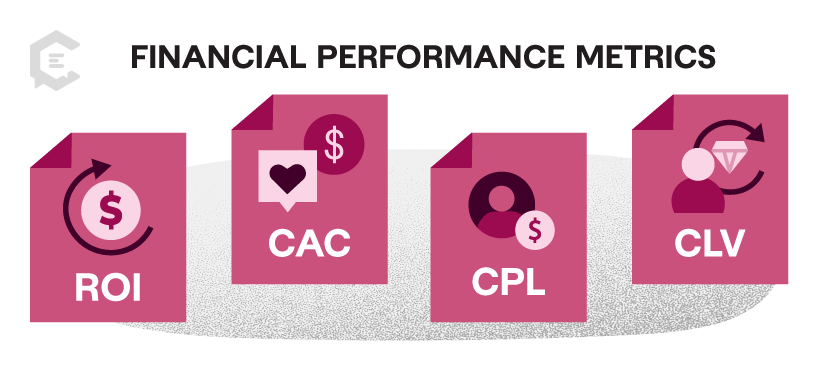Think of your favorite movie. Once you have it in your mind, think about what you’re seeing. You’re probably imagining a favorite scene or sequence. Maybe even a performance.
Regardless of what it is, you’re definitely envisioning the finished creative product — the end result.
What we don’t think of right away is all the behind-the-scenes production that goes into making the film, like:
- Procuring finances and budgeting
- Writing the script
- Preproduction
- Coordination of production logistics
- Filming the movie
- Post-production editing
- Finding distribution
- Releasing/promoting the movie
Just as a movie’s success depends on seamlessly integrating different stages, so does your content marketing — the key to that seamless integration — your content operations.
Content operations bring stability and consistency to every level of your content marketing. One of the best ways to ensure that is to integrate analytics into your content operations framework.
In this article, we’ll explore the critical role analytics plays in your content operations. We’ll cover the best metrics to track, how to use analytics to optimize operations, the top challenges, and the best tools on the market to level up your tech stack.

What are Content Operations?
Before diving deep into all the analytics, let’s do a quick primer on content operations for peace of mind.
Content operations are the systems, processes, people, and tools that manage and produce your content lifecycle from start to finish. It covers everything from strategic planning to content creation to publishing and distribution.
Bottom line, content operations empower you to give your customers the best possible experience of your brand throughout their buyer’s journey as smoothly and effectively as possible with the resources you’ve been allocated.
But to achieve success in your operations, and therefore your content creation and strategy, you need to understand the metrics behind your marketing.
Key Metrics for Content Operations
Every organization is unique. As you build your content operations framework, your chosen metrics will be your guideposts. Let’s break down the most important ones to monitor. We’ll categorize them into two primary categories:
- Financial performance
- Efficiency and productivity
First up, finance.

Financial performance metrics
Ah, the money metrics. These four metrics will give you a comprehensive view of the financial impact of your content marketing efforts. They’ll also provide key data to help you make a compelling business case for your content marketing to get (or keep) executive buy-in:
- Return on investment (ROI): The big one. It measures the return achieved on every dollar spent.
- Customer acquisition cost (CAC): The total price of winning a new customer.
- Cost-per-lead (CPL): Measures how much you’re paying to generate potential customers and whether it’s cost-effective.
- Customer lifetime value (CLV): Estimates the total revenue a business can expect from a single customer account throughout their relationship with the company.
Efficiency and productivity
Although you can use a range of KPIs in your content marketing, we’ll focus on the ones that can support your content operations the most. Tracking these will help you fine-tune your content strategy to ensure you’re resonating with your audience, driving engagement, and increasing conversion rates. The more effective your content is, the more time and money you’ll save.
- Organic search traffic: The number of visitors who come to your site from natural (unpaid) search engine results.
- Views & impressions: Views are when someone watches or engages with your content. Impressions are when your content or advertisement is displayed on someone’s screen.
- Keyword rankings: The position of your website’s content in search engine results for specific keywords.
- Engagement metrics: How users are interacting with your content. They include:
- Avg time on page: The average time visitors spend viewing a specific page.
- Avg engagement rate: How actively involved your audience is with your content.
- Bounce rate: The percentage of visitors who leave your site after viewing only one page.
- Churn rate: The rate at which you lose subscribers or customers over a given period.
- Content decay rate: The rate at which content loses its traffic or relevance over time.
- Click-through rate: The percentage of visitors who click on a desired link in your content.
- Conversion rate: The percentage of visitors who take a desired action (signing up, making a purchase) after interacting with your content.
- SQLs: Prospects who are bottom-of-funnel (BOFU), primed to buy, and ready for a direct sales pitch.

Using Analytics to Optimize Content Operations
Analytics equals data. And data is the backbone of navigating your content operations. It can enhance every aspect of your content lifecycle, supporting how your content marketing is planned, executed, and evaluated.
Here’s how to integrate it.
Guiding operations with data-driven decision making
To some people, it sounds romantic to “rely on your gut” when making business decisions. But these days, you don’t have to. Instead, data gives you concrete insights that you can use to make the most informed decisions possible.
Here’s how they can help your operations:
- Budget allocation: The above metrics can help you determine which content strategies yield the best ROI, informing your financial planning and guiding where to allocate or cut content budget for maximum effectiveness.
- Predictive forecasting: Metrics like CLV help predict future revenue streams from different audience segments, helping your long-term financial planning.
- Resource optimization: Engagement and traffic metrics can measure the most effective content types to identify what’s working and what’s not. Then, you can allocate human and tech resources accordingly.
- Workflow improvement: Analytics can pinpoint inefficiencies and identify bottlenecks in the content operations process, improving the flow of content creation, management, and distribution.
- Strategic pivoting: Data on content decay, bounce rates, and churn rates can tell you when to adjust your content, ensuring it remains relevant and resonant.
Continuously refining your operations
As marketers, we know that refining and adjusting your content marketing goals never ends. It’s the same for your content operations. But you don’t have to do it alone. Analytics can be your best friend here by providing new data and insights into your process’s effectiveness through things like:
- A/B testing: A/B testing is a great technique to experiment with different content types, styles, and distribution channels. Your analytics can measure your content’s performance in real time and tell you what resonates with your audience the most.
- Resource reallocation: You’ve already used analytics to allocate your resources (hopefully). You can also use them to monitor your content strategy performance if anything changes, ensuring you always use your resources the most effectively.
- Feedback loops: You can implement processes that regularly collect and analyze feedback from your audience (and internal teams). Then, you can make improvements to your content.
- Performance benchmarks: Analytics can set up your success by establishing clear benchmarks based on past data. Those benchmarks will give your operations a target standard of performance.
The consistent flow of information that analytics provide keeps your content operations dynamic and responsive while also ensuring long-term sustainability and success.
Top Challenges in Content Operations Analytics
A big part of content operations revolves around making the best use of cutting-edge technology. The right tech stack can make or break the success of your operations and, therefore, your strategy.
Here are two of the biggest hurdles to overcome when using analytics in your content operations:

Data overload
This is the age of big data. You’d be hard-pressed to find a marketer that doesn’t use data to support their decisions. But there’s a vast amount of information out there, and it can be daunting to sift through all the metrics and data points available. The key is to focus on what truly matters.
Here’s how to do that:
- Prioritize the most relevant metrics: Create your content goals first. Make sure they reflect your overall business objectives. Then, identify and focus on metrics that directly impact those goals.
- Implement data management tools: Tools like Google Analytics, Hubspot, and Tableau can aggregate, filter, and visualize data for easier interpretation. And they do it almost instantaneously (more on them later).
- Regular data audits: Just like you’re doing regular content audits, you should also be doing periodic data audits. It ensures the data you’re tracking stays relevant to your content strategy as it evolves.
- Building a skilled team: We’re not serving our robot overlords yet. Invest in hiring personnel who specialize in data analysis and interpretation. Or train someone in-house. Every superhero content strategy needs “someone in the chair.” If you get the reference, we see you.
Adopt these strategies; overwhelming data will become actionable insights, taking your content operations to the next level.
Integrating analytics into existing operational frameworks
You don’t want data to be an isolated aspect of your content operations. It needs to be folded into the rest of your operations and marketing strategy. Every aspect of your organization should benefit from your operational analytics.
Here are two ways to integrate them effectively:
A centralized analytics platform
One of the easiest ways to integrate data is using a centralized analytics platform that aggregates data from multiple sources and provides a holistic review of all content-related analytics. It can include everything from website to social media to email campaign analytics. Think of tools like Google Analytics, Tableau, or Adobe Analytics.
Content Management Systems (CMS) with built-in analytics
Many modern CMS platforms can measure content performance directly within their system. That integration allows for real-time tracking and analysis of how content is performing. Look at tools like WordPress with plugins like Yoast SEO or HubSpot’s CMS. Both offer robust analytics features.

The Best Tools for Content Operations Analytics
Alright, you’ve finally sifted through all the possible metrics and chosen ones that match your content goals. But wait! You’re not done yet! Now, it’s time to choose the tools that track those metrics.
Your all-in-one solutions
Comprehensive analytics platforms offer a wide range of analytical capabilities, making them a one-stop solution for content operations.
- HubSpot: Easily integrate HubSpot’s analytics into your marketing dashboard. Use HubSpot to ensure each piece of content is strategically aligned with the broader business and sales goals. Regularly review the data to adjust your content strategy as needed.
- Google Analytics: This is a no-brainer. Ensure you have GA implemented for detailed website traffic tracking and user behavior. Refine your SEO and content strategy through your findings to tailor content to your audience’s preferences.
- Salesforce: Link your content performance to customer relationships. Leverage Salesforce to monitor customer interaction across various channels. Apply predictive insights from Salesforce to anticipate customer needs and tailor your future content strategies.
- Zoho: Simplify data analysis for your content teams by integrating its user-friendly interface and customizable dashboard into your content teams’ toolkit. Turn complex data into accessible and actionable insights through their analytics and third-party tool integrations, making your decision-making more effective for content planning.
Your niche tools for specific metrics
While comprehensive platforms offer a broad overview, niche tools specialize in tracking specific metrics, offering more detailed insights in particular areas. These are ideal for content operations with specific needs or for complementing the data from all-in-one platforms. It just depends on what you need.
SEO and Keywords
- SEMrush: Much more than backlinks and ranking data; Get real-time recommendations for content optimization. Input one or more target keywords into an SEO Content Template and receive insights into your competition, relevant keywords to include, and your content length. You can use this information to create a content brief or copy directly.
- Moz: Moz is excellent for keyword research, link analysis, and site audits, emphasizing your site’s domain authority. Apply your findings from continuous site audits and link analysis to improve your site’s SEO performance and enhance your overall content strategy. Protip: Moz Pro tracks the top 50 ranking positions for your tracked keywords.
- Ahrefs: Leverage Ahrefs for advanced backlink analysis, examining your and competitors’ link profiles. Identify opportunities to enhance off-page SEO and further optimize by building high-quality backlinks to improve your site’s authority and rankings.
Social Media
- Hootsuite: As one of the most robust social media management platforms, your content teams can schedule posts, track engagement, and analyze social content performance across multiple platforms.
- Buffer: A simple, straightforward, and efficient social media management tool. It has a user-friendly interface that makes it easy to access your data and understand your social impact.
- Quintly: Specializes in audience engagement, competitor performance, and content effectiveness across various platforms. Ideal for the content operations needing more detailed social media analysis.
- Sprout Social: A more holistic option. It combines analytics with engagement tools and customer service features. Valuable for understanding and improving target audience interactions.

Content engagement and trends
- BuzzSumo: Capitalize on content trends and engagement with BuzzSumo. Identify potential viral topics and current trends relevant to your audience. From there, create content that resonates deeply with your target audience, enhancing engagement and reach.
- SimilarWeb: Employ SimilarWeb for deep insights into audience behavior and competitive benchmarking. Analyze these insights to identify new opportunities, emerging trends, and strategies to remain competitive.
- Kissmetrics: Optimize the customer journey with Kissmetrics. Implement this tool for detailed analysis of individual user behavior to develop resonate content strategies, improving user experience and conversion rates.
- Funnel.io: Streamline ad performance analysis across multiple platforms. This enables a more efficient evaluation of your paid efforts and multi-channel campaigns, helping to optimize spending and improve ROI.
Data consolidation
- Tableau: Easily translate complex data sets into clear, straightforward visual insights. Tableau is crucial for presenting and communicating content performance and insights to your many stakeholders, informing and streamlining their decision-making process.
- Power BI: Leverage real-time insights within a Microsoft ecosystem. Ensure seamless integration and efficient data management.
Take the Next Step in Your Content Operations
Elevating your content operations game is critical to unlocking the full potential of your content marketing. Because with the right operational framework in place, the sky’s the limit. If you’re ready to take that step now, ClearVoice is here to help. Our team of experts and customized content plans can help you streamline your workflows and produce results that matter.
Talk to a strategist today to get started.



